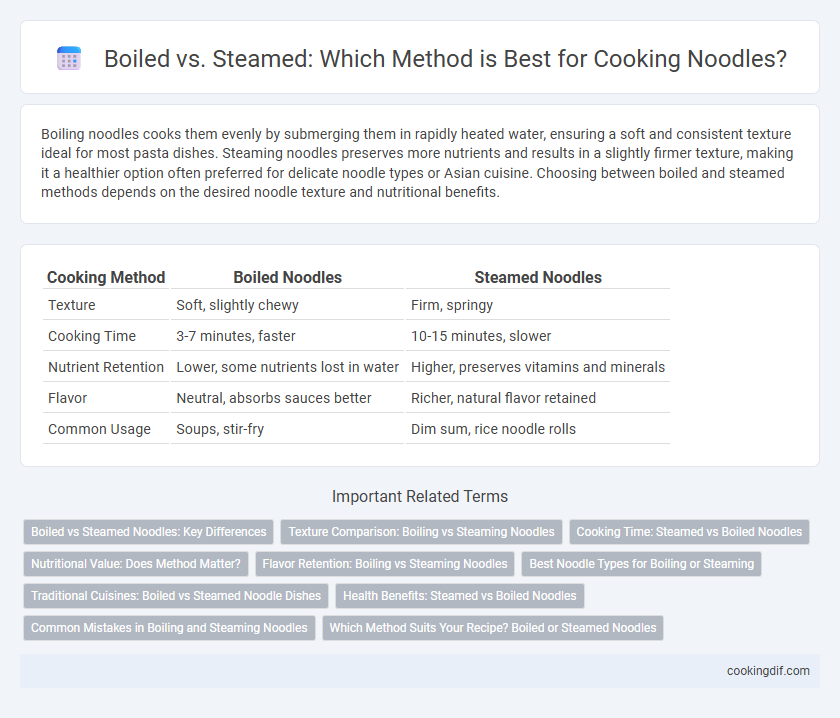Boiling noodles cooks them evenly by submerging them in rapidly heated water, ensuring a soft and consistent texture ideal for most pasta dishes. Steaming noodles preserves more nutrients and results in a slightly firmer texture, making it a healthier option often preferred for delicate noodle types or Asian cuisine. Choosing between boiled and steamed methods depends on the desired noodle texture and nutritional benefits.
Table of Comparison
| Cooking Method | Boiled Noodles | Steamed Noodles |
|---|---|---|
| Texture | Soft, slightly chewy | Firm, springy |
| Cooking Time | 3-7 minutes, faster | 10-15 minutes, slower |
| Nutrient Retention | Lower, some nutrients lost in water | Higher, preserves vitamins and minerals |
| Flavor | Neutral, absorbs sauces better | Richer, natural flavor retained |
| Common Usage | Soups, stir-fry | Dim sum, rice noodle rolls |
Boiled vs Steamed Noodles: Key Differences
Boiled noodles absorb water directly, resulting in a softer texture and faster cooking time, making them ideal for soups and stir-fries. Steamed noodles maintain a firmer bite and a chewier consistency by cooking with steam heat, preserving more of their natural starches and preventing sogginess. The choice between boiling and steaming noodles significantly impacts their texture, moisture content, and suitability for various dishes.
Texture Comparison: Boiling vs Steaming Noodles
Boiled noodles typically have a softer, more tender texture as the hot water fully hydrates and gelatinizes the starches, resulting in a consistent chewiness. Steamed noodles maintain a firmer, slightly elastic texture since the indirect heat preserves some structural integrity without overhydration. This textural difference makes boiling ideal for traditional Asian noodle soups, while steaming suits dishes requiring a resilient, non-mushy bite.
Cooking Time: Steamed vs Boiled Noodles
Boiled noodles typically require 3 to 5 minutes to cook, as the high temperature of rapidly boiling water helps them soften quickly and evenly. Steamed noodles often take longer, around 8 to 10 minutes, because the gentler heat of steam gradually penetrates the dough, preserving texture but extending cooking time. Choosing between boiling and steaming depends on the desired noodle consistency and recipe requirements, with boiling favored for speed and steaming preferred for a chewier texture.
Nutritional Value: Does Method Matter?
Boiling noodles can lead to some nutrient loss, especially water-soluble vitamins like B vitamins and minerals, due to leaching into the boiling water. Steaming noodles preserves more nutrients by minimizing direct contact with water, maintaining higher levels of vitamins and antioxidants. Choosing steaming over boiling can enhance the overall nutritional profile of noodles while retaining their texture and flavor.
Flavor Retention: Boiling vs Steaming Noodles
Boiling noodles often causes some flavor compounds to leach into the cooking water, resulting in a slight loss of noodle taste. Steaming preserves more of the noodle's natural flavors by minimizing contact with water and retaining essential oils and starches. This method enhances the noodle's original texture and subtle taste, making steaming preferable for dishes aiming for intensified flavor profiles.
Best Noodle Types for Boiling or Steaming
Wheat-based noodles like ramen, udon, and soba are best suited for boiling, as their structure softens evenly and absorbs flavors well in hot water. Rice noodles and glass noodles perform better when steamed, maintaining a tender yet firm texture without becoming overly mushy. Egg noodles can be boiled for soups or quickly steamed in dim sum dishes, showcasing their versatility in different cooking methods.
Traditional Cuisines: Boiled vs Steamed Noodle Dishes
Traditional cultures showcase distinct preferences for boiled or steamed noodle preparations, each method enhancing texture and flavor uniquely. Boiling noodles, common in Chinese and Italian dishes, yields a soft yet firm texture ideal for soups and pasta sauces, while steaming, prevalent in Southeast Asian cuisines, produces a chewier consistency perfect for dim sum or layered noodle cakes. Understanding these cooking techniques illuminates the culinary heritage and textural versatility inherent in classic noodle dishes worldwide.
Health Benefits: Steamed vs Boiled Noodles
Steamed noodles retain more nutrients and have a lower glycemic index compared to boiled noodles, supporting better blood sugar regulation. Boiling noodles leaches some vitamins and minerals into the water, reducing their nutritional value. Choosing steamed noodles promotes improved digestion and sustained energy release due to preserved fiber content.
Common Mistakes in Boiling and Steaming Noodles
Common mistakes in boiling noodles include overcrowding the pot, which causes uneven cooking and sticky clumps, and not salting the water properly, resulting in bland noodles. When steaming, a frequent error is using insufficient water or inadequate steaming time, leading to undercooked or mushy noodles. Oversteaming or boiling too vigorously breaks noodles down, reducing their texture quality and flavor absorption.
Which Method Suits Your Recipe? Boiled or Steamed Noodles
Boiling noodles ensures even cooking and a soft, chewy texture ideal for soups and stir-fries, while steaming preserves a firmer bite and enhances flavor absorption, making it suitable for delicate dishes like dim sum or cold noodles. Choosing between boiled or steamed noodles depends on the desired texture and recipe style; boiled noodles excel in quick-cooking, moisture-rich recipes, whereas steamed noodles work best for layered or sauce-infused dishes. Understanding the noodle type and cooking outcome helps optimize preparation for authentic taste and texture in your culinary creation.
Boiled vs steamed for noodle cooking Infographic

 cookingdif.com
cookingdif.com